Bull Terrier
The Bull Terrier is a breed of dog in the terrier family. There is also a miniature version of this breed which is officially known as the Miniature Bull Terrier.
| Bull Terrier | |||||||||||||||||||||||||||||
|---|---|---|---|---|---|---|---|---|---|---|---|---|---|---|---|---|---|---|---|---|---|---|---|---|---|---|---|---|---|
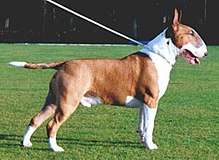 | |||||||||||||||||||||||||||||
| Other names |
| ||||||||||||||||||||||||||||
| Origin | England | ||||||||||||||||||||||||||||
| |||||||||||||||||||||||||||||
| |||||||||||||||||||||||||||||
| Dog (domestic dog) | |||||||||||||||||||||||||||||
Appearance
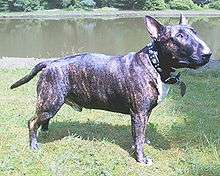
The Bull Terrier's most recognizable feature is its head, described as 'egg-shaped head', when viewed from the front; the top of the skull is almost flat. The profile curves gently downwards from the top of the skull to the tip of the nose, which is black and bent downwards at the tip, with well-developed nostrils. The lower jaw is deep and strong. The unique triangular eyes are small, dark, and deep-set.[2] Bull Terriers are the only dogs that have triangular eyes. The body is full and round, with strong, muscular shoulders. The tail is carried horizontally. They are either white, red, fawn, black, brindle, or a combination of these.[3]
Temperament
Bull Terriers can be both independent and stubborn[4] and for this reason are not considered suitable for an inexperienced dog owner. A Bull Terrier has an even temperament and is amenable to discipline. Although obstinate, the breed is described by the Bull Terrier Club as particularly good with people.[5] Early socialisation will ensure that the dog will get along with other dogs and animals.[6] Their personality is described as courageous, full of spirit, with a fun-loving attitude,[5] a children-loving dog and a perfect family member. Although the breed has been a target of breed-specific legislation, a 2008 study in Germany did not find that Bull Terriers had any significant temperament difference from Golden Retrievers in overall temperament researches.[7]
Health
All puppies should be checked for deafness, which occurs in 20.4% of pure white Bull Terriers and 1.3% of colored Bull Terriers[8] and is difficult to notice, especially in a relatively young puppy. Many Bull Terriers have a tendency to develop skin allergies.[9] Insect bites, such as those from fleas, and sometimes mosquitoes and mites, can produce a generalised allergic response of hives, rash, and itching. This problem can be stopped by keeping the dog free of contact from these insects, but this is definitely a consideration in climates or circumstances where exposure to these insects is inevitable. A UK breed survey puts their median lifespan at 10 years and their mean at 9 years (1 s.f., RSE = 13.87% 2 d. p.), with a good number of dogs living to 10–15 years.[10]
History
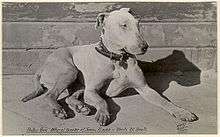
At the start of the 19th century the "bull and terrier" breeds were developed to satisfy the needs for vermin control and animal-based blood sports. The bull and terriers were based on the Old English Bulldog (now extinct) and Old English Terriers with possible other terriers. This new breed combined the speed and dexterity of lightly built terriers with the dour tenacity of the Bulldog, which was a poor performer in most combat situations, having been bred almost exclusively for fighting bulls and bears tied to a post. Many breeders began to breed bulldogs with terriers, arguing that such a mixture enhances the quality of fighting. Despite the fact that a cross between a bulldog and a terrier was of high value, very little or nothing was done to preserve the breed in its original form. Due to the lack of breed standards—breeding was for performance, not appearance—the "bull and terrier" eventually divided into the ancestors of "Bull Terriers" and "Staffordshire Bull Terriers", both smaller and easier to handle than the progenitor.[11]
In the mid-19th century James Hinks started breeding bull and terriers with "English White Terriers" (now extinct), looking for a cleaner appearance with better legs and nicer head. In 1862, Hinks entered a dam called "Puss" sired by his white Bulldog called "Madman" into the Bull Terrier Class at the dog show held at the Cremorne Gardens in Chelsea. Originally these dogs did not yet have the now-familiar "egg face", but kept the stop in the skull profile.[12] The dog was immediately popular and breeding continued, using Dalmatian, Spanish Pointer, and Whippet to increase elegance and agility; and Borzoi and Rough Collie to reduce the stop. Hinks wanted his dogs white, and bred specifically for this. The first modern Bull Terrier is now recognised as "Lord Gladiator", from 1917, being the first dog with no stop at all.[11][13]
Due to medical problems associated with all-white breeding, Ted Lyon among others began introducing colour, using Staffordshire Bull Terriers in the early 20th century. Coloured Bull Terriers were recognised as a separate variety (at least by the AKC) in 1936. Brindle is the preferred colour, but other colours are welcome.[12][14]
Along with conformation, specific behaviour traits were sought.
- Bull Terrier
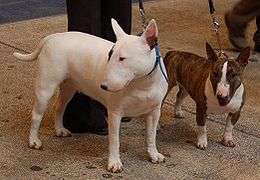 With a Miniature Bull Terrier
With a Miniature Bull Terrier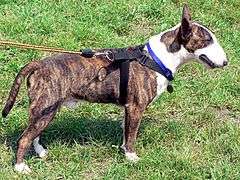 Brindle and white Bull Terrier
Brindle and white Bull Terrier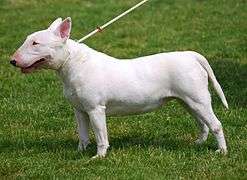 White Bull Terrier
White Bull Terrier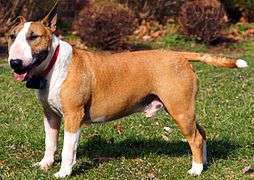 Red and white Bull Terrier
Red and white Bull Terrier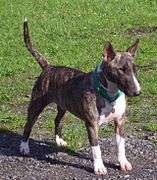 Modern-colored Bull Terrier
Modern-colored Bull Terrier
Noted Bull Terriers
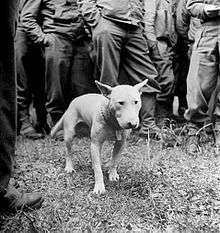
- Theodore Roosevelt owned several pets, including the Bull Terrier Pete. Pete received plenty of contemporary press, having bitten a naval clerk as well as chased and bitten the French ambassador.[15][16][17]
- General George S. Patton owned a Bull Terrier named Willie. The dog had belonged to a fallen RAF pilot, and Patton bought him in England in 1944. When it got into a fight with Dwight D. Eisenhower's dog, Patton apologised, saying that Willie was outranked and would be confined to quarters.[18][19][20]
See also
References
- "Bull Terrier Dog Breed Information, Pictures, Characteristics & Facts - Dogtime". Archived from the original on 30 October 2016.
- Mason, Walter Esplin (14 August 1915). "Dogs of all nations". [S.l.: s.n.] – via Internet Archive.
- CKC Breed Standards, ckc.ca, archived at the Wayback Machine, 20 February 2008.
- Breeder Retriever. "Bull Terrier Temperament". Archived from the original on 3 February 2012.
- "BREED STANDARD - The Bull Terrier Club". Archived from the original on 20 November 2015.
- "ADBA American Pit Bull Terrier Puppy Socialization". adbadog.com. 8 February 2018. Archived from the original on 30 July 2017.
- Ott, Stefanie A.; Schalke, Esther; von Gaertner, Amelie M.; Hackbarth, Hansjoachim (May - June 2008). "Is there a difference? Comparison of golden retrievers and dogs affected by breed-specific legislation regarding aggressive behavior". Journal of Veterinary Behavior. Volume 3, Issue 3, Elsevier Inc. pp. 134–140
- Breed-Specific Deafness Prevalence In Dogs (percent) Archived 28 January 2013 at the Wayback Machine. LSU.edu
- Richards, Michael. Skin Disorders and Problems of Dogs Archived 20 November 2007 at the Wayback Machine, vetinfo4dogs.com
- "Individual Breed Results for Purebred Dog Health Survey". Archived from the original on 4 May 2007.
- "Canterbury Bull Terrier Club". 21 November 2008. Archived from the original on 21 November 2008.
- American Kennel Club:Bull Terrier History Archived 5 August 2015 at the Wayback Machine, akc.org
- ANKC: Extended Breed Standard of The Bull Terrier & Bull Terrier (Miniature) Archived 22 July 2008 at the Wayback Machine, ankc.org.au
- T.W. Hogarth published The Coloured and Colour Breeding, Galashiels: A Walker & Son in 1932, which included chapters – 'Colour Breeding in Bull Terriers' by Major T Grahame and Captain J.N. Ritchie and 'Colour Inheritance in Bull-terriers' by Dr F Fraser Darling.
- Coren, Stanley. The Pawprints of History: Dogs in the Course of Human Events. Simon and Schuster. p. 279. ISBN 978-0-7432-2770-4.
- Dickey, Bronwen. Pit Bull: The Battle over an American Icon. Knopf Doubleday Publishing Group. p. 67. ISBN 978-0-307-96177-8. Retrieved 13 August 2020.
- "21 of Theodore Roosevelt's Most Memorable Pets". Mental Floss. 23 December 2019. Retrieved 13 August 2020.
- Amanda Macias, "This photo shows Gen. Patton's dog Willie after the general's death" Archived 10 April 2016 at the Wayback Machine, Business Insider, 21 December 2015.
- D'Este, Carlo. Eisenhower: A Soldier's Life. Henry Holt and Company. ISBN 978-1-62779-961-4. Retrieved 13 August 2020.
- Forty, George. Patton's Third Army at War. Casemate. ISBN 978-1-61200-316-0. Retrieved 13 August 2020.
External links
| Wikimedia Commons has media related to: |